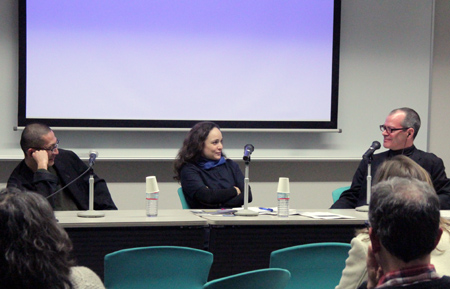[Report] Film Screening: "No Man's Zone"
On January 24th, UTCP hosted a public screening of Fujiwara Toshi's documentary No Man’s Zone. Following the screening, Fujiwara-san joined Mark Roberts and Élise Domenach of UTCP for an in-depth discussion with the audience.
No Man’s Zone was filmed on the eve of the evacuation order for the 20 km exclusion zone surrounding the Fukushima No. 1 power station in 2011. The camera explores the now-forbidden landscapes, and the lives of the inhabitants directly affected by the crisis. It is constructed as a philosophical essay, reflecting on questions concerning visible and invisible destruction, and especially our relationship to images of disaster.
As we approach the three-year mark from the Tohoku disaster and beginning of the nuclear crisis, it seemed important to cast our gaze back, to consider this uniquely thoughtful documentary record of the events, and in this fashion to reflect on our understanding of the ongoing crisis.

In the post-screening discussion, Fujiwara-san described the present situation in the exclusion zone, the evolution of the media representation of the crisis, and his approach to the crisis as a documentary filmmaker. Nearly three years have passed since filming began. Where do things stand today?
At present (January 2014), the most contaminated areas remain closed behind metal gates. Only the local residents have keys that allow entry to these areas. However, their right to enter is on the condition that they will only stay briefly, and they are not allowed to remain overnight. In short, the situation remains essentially unchanged since the terms of limited access were established in July of 2012. The contaminated areas have been officially divided into zones categorized by three different levels of radioactivity, with residence prohibited. A decision on a return date for the evacuees has been repeatedly postponed by the government, and many of them remain in temporary housing. By law, this was to be provided for two years, but now it is clear the evacuees will be in temporary accommodations for at least four or five years.
Thus, the exclusion zone is today a kind of wasteland, with the government pretending to make an effort so that the residents can return. In fact, though, the levels of radioactivity are such that this is not possible. Much of the "natural" environment in these areas was gradually shaped by the inhabitants as they cleared trees, brush, etc., and in their absence it is once again reverting to a wild state. Fujiwara-san points out that in some ways the present situation has become even more contradictory. For example, there are people in the area who are employed by TEPCO, and who received compensation for the contamination and subsequent loss of their property. But now the utility company is asking them to pay back some of the compensation, placing them in a difficult position vis-à-vis their employer.
The spatial organization of the TEPCO system is interesting in that nearly all of its power stations are located outside of the area they serve. No Man's Zone explores this dimension of the crisis, and Fujiwara-san elaborated on it during the discussion. The origin of this configuration dates back to the 1933 Sanriku earthquake [Shōwa Sanriku Jishin], after which the local power infrastructure was dramatically restructured to provide for the Tokyo-Yokohama area, several hundred kilometers away, especially for the heavy industry involved in the war effort against China. Historically, then, the logic of "nationalization" was inscribed within the configuration of a war economy. Fujiwara-san points out that the formation of this system can in fact be traced even further back, to the Meiji Restoration, and Boshin War in Tohoku.

In this respect, No Man's Zone also offers a nuanced perspective on questions of victimhood and complicity. For, while a large number of people in the exclusion zone were employed by TEPCO or its subsidiaries, the film doesn't take the position that they were complicit with the disaster. Rather, Fujiwara-san draws our attention to the conditions surrounding a broader and grossly unequal power relation between Tokyo and Tohoku that is co-incident with the emergence of modern Japan.
Through conversation and the audience Q & A, we explored a number of questions concerning the current conditions in Fukushima, and their representation in both documentary film and mass media. In closing, the members of UTCP wish to express their sincere thanks to Fujiwara-san for a very thought-provoking discussion.
— M. Downing Roberts, UTCP






